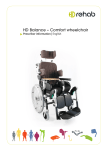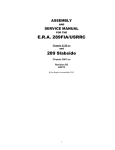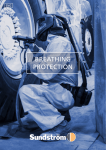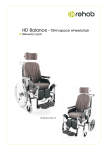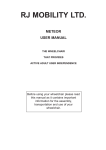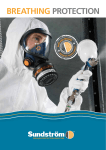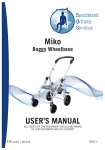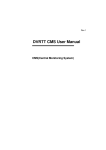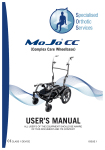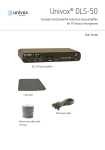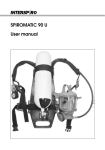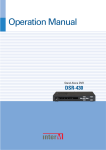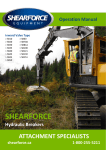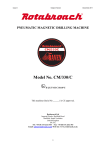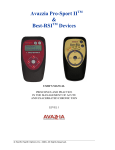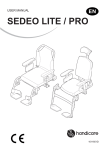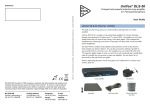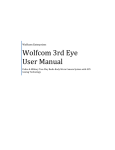Download 95008-1 - HD Rehab
Transcript
USER MANUAL For Tilt In Space Hantverksdesign Wheelchair Art.nr. 95 008-1 Rev. 021211 Contents Side 2. 3. 4. 5. 6-8 9 10 11-13 14-16 18 19 Contents Identifying models Wheelchairs parts Brakes Wheels, anti-tippers Seat, back, covers, push bars Arm support Folding Leg rests Accessories Maintenance Technical data/measuring table Model production number (NR) A label with the model and the manufacturing number of the wheelchair is placed on the front frame of the chair (see picture 2a) 1pic 2a This User Manual’s contents applies to the following wheelchair models: Model 500 Model 600 Model 800 The models with bold print are the most usual and are the ones illustrated in this user manual. 2 Wheelchair parts: 8 9 11 7 12 10 13 1 3 2 4 6 14 5 15 pic 3a 1 2 3 4 5 6 7 8 Leg rest Foot plate Ankle support Driving wheel Castors Parking brake Arm support Push bar pic 3a 9 10 11 12 13 14 15 Brake handle Brake lock Back adjustment lever Seat adjustment lever Thorasic support fastening Folding pin Anti tipping protection Standard equipment: Removable adjustable leg supports Arm rests are adjustable height/depth Puncture free tyres Tipping protection Attendant assisted disc braking Quick release wheels Angled seating with built in pressure relief Angled & contoured back rest Adjustable seat depth Removable washable seat & back cushions Removable other fabric covers Height adjustable push bar Thorasic support fastening 3 Brakes Combined braking All models have standard braking equipment. Brake used by the carer is a braking bar located on the back of the chair beneath the push handle. The brake operates the disc brakes on each wheel. NB: some chairs can be equipped with separate push handles but the braking system is the same. Brake bar: The brake is manoeuvred by pulling up the brake handle (1) against the push bar (2) see picture 4a. 3 1 pic 4a 2 Parking brake: Pull the braking handle (1) see picture 4 a up towards the push bar (2) and push the lock sleeve forward (3) so that the handle is locked in the braking position, see picture 4b pic 4b NB: One lock on each side, make sure that the brake sleeve is securely pushed on so that the wheelchair is safely braked. Parking brake on models fitted with 24” wheels: On model 500 there is a separate parking brake for the user. This brake is fitted on the wheel rim, see picture 4c. At braking pull the lever (6) forward from the wheel. There is a braking lever on each side. Adjusting the tyre brake: - Loosen the stop screws (7) - Push the brake to or from the tyre. - Screw in tight to the stop screw. IMPORTANT adjustment of brakes should be done by trained staff 7 6 pic 4c Adjusting disc brakes: The disc brakes can be adjusted in the following manner: See picture 4d, loosen the nut (8) a couple of turns. Turn the screw (9) so that suitable braking power is achieved. Test the braking on the driving handle and adjust so that both wheels have the same braking power and then tighten the nut (8). 4 NB: To try out the braking power the wheels must be fitted. IMPORTANT adjustment of brakes should be done by trained staff pic 4d 9 8 Wheels All wheels are fitted with puncture proof tyres (pneumatic is option) . The driving wheels are quick release and are either 24” or 12 ½” wheels. Releasing the wheels: Push in the locking knob (1) on the underside of the wheel hub, see picture 5a. Loosen the wheel and take off. Mounting wheels: Put the wheel axle into the socket (2) on the wheel hub see picture 5b. Push in the lock knob (1) on the underside of the wheel hub. Push in the wheels so that the three metal pegs on the wheel hub fits into the three holes in the braking plate. Let go of the locking knob and check that the wheel is on securely. 1 picture 5a IMPORTANT Check that the wheel release button has locate and that the wheel is secure. Moving forward the driving wheel. This can only be done on model 500 (not on children’s’ models) See special documentation. IMPORTANT Moving forward the driving wheel should be done by trained staff only. 2 picture 5b 1 Tipping protection/bar Tipping protection is standard on models 500, 600 and 800. See picture 5c and 5d. The tipping protection can be pulled out or pushed in (lock) picture 5d. Please note check the locking nut has slid out of its hole properly. Always have the tipping bar extended out if there is a risk of tipping backwards. 3 picture 5c 4 3 picture 5d 4 5 Seat and back The control levers for control of the seat and back angles are on the back of the back support, see picture 6a. The levers are positioned on each side of the head rest fastening. The levers should be handled with average force. Picture 6b shows the chair with the back and seat at the maximum angle with standard gas assisted spring mounted. picture 6a Tipping protection picture 6b Seat angling mechanism. The tipping lock is fitted with an adjustable brake, see picture 6d. The brake (1) is adjusted with a Philips screwdriver and is adjusted to the required for resistance and the weight of the user. To get access to the tipping lock the cover (2) picture 6c, has to be removed. The cover is fixed with spring loaded hooks on the frame bar and can be removed without tooling. picture 6c 2 6 picture 6d 1 Back angling, left adjuster: Control left lever. - Grasp the driving bar with one hand. - Free the lever by putting the lever to the side. Adjust the angle by using the push bar as a jack and let go of the lever. Do not use the lever as a jack. The angle of the back is adjustable by the gas spring with a smooth action. As an option there is a variant for increasing the back angle. The tipping risk is increased and extended tipping protection should be used. Seat angling: See side 5. Right side: Grasp the push bar with one hand and free the lever by putting the lever to the side. Adjust the angle by using the push bar as a jack and let go of the lever. The angle of the seat is adjustable into approx 10 positions . As an extra there is a variant for increasing the seat angle, with an extended tip bar. The tipping risk should be taken into consideration. Please see special fitting manual. Adjustable seat: The seat depth can be adjusted into 4 positions, see picture 7a for depth : - put the lever 1 to the side (left). - push the seat to desired position. - let go of the lever and push the seat so that the lever is locked into position. - check that the seat is properly locked into position. Removable seat and back cushions: Seat and back cushions are fastened on to the wheelchair with velcro (2) see picture 7a, and easy to remove/change. Alternative cushions and covers are available. To fit the cushions: - fasten the poppers on top of the back cushion on the back of the back board (3) according to picture 7c (this is so that the cushion is in the correct position). - put the cushion forward push fast against the back board according to picture 7d. - check that the cushion is properly fastened. To remove the back cushion: - take hold of the lower edge of the cushion and pull outwards and upwards. 1 Please note that the normal adjustment position is the position next to the last one at the back. Please note depending upon the position of the back there could be a risk of squeezing between the back bar and the seat board this could happen if the user is in the chair. 2 picture 7a Fitting seat cushion. - place over seat board and push down. - check that the cushion is in place. Removing the seat cushion: - take hold of the front of the cushion and pull up. picture 7b 3 picture 7c picture 7d Removable covers: Both seat and back cushion covers are fitted with zips. The front of the zip you will find on the back of the cushion. Washing advice is on label inside the cover. Option: The cloth cover has incontinence protection ( only seat ) or a vinyl cover. When the cover is removed small modifications can be done simply to the upholstery For instance to increase the support of the lower back. 7 Height of the seat back: The height of the seat can be adjusted 3 cms up and 4 cms down. This requires a 4 mm Allen key. Height adjustment of the back - loosen the screws (1) picture 8a a couple of turns (4 pcs). - carefully push the back up or down. - fasten the screws properly. 1 Please note! Check carefully that the brake wires are not damaged when the back is adjusted. Please note! When the back is moved to maximum height that top hole on the back frame is covered. The push bar can be restricted and not able to be used at its highest position. pic 8a 2 Pushbar: Separate driving handles: The chair is normally delivered with push bar (2) (picture 8b) Adjusting the height of the push bar: - grasp the push bar with one hand - push in the lockpin (3) and pull the push bar up - hold it up and push in the second lockpin (4). - put the push bar in the desired position. Note: Check that both locks are positioned in the holes in the back frame. Please note that the brake cables are free and should lie along the back frame. The chair as an alternative can be equipped with separate push handles (5) picture 8c. Adjusting the height of the handles: - loosen screws (6) completely. - move the handles until the desired position and fasten the screws. Check that the screws are properly fastened. Check that the brake cables are running freely and not damaged. They should run freely along the back frame. 4 3 pic 8b 5 6 pic 8c 8 Armrest Armrest can be adjusted for height and depth and consists of the following parts. 1. Arm rest board picture 9a 2. Side panel picture 9 a 3. Locking catch picture 9a 4. Locking tongue picture 9 b 2 1 3 (6) b picture 9a a Height adjustment: - Loosen the lock (3) - Put the armrest into position and lock again (5) 4 picture 9b Depth adjustment: The arm plate can be put in 4 positions push in the locking catch and put into the desired position. 3 picture 9c Hemiplegic armrest 7 8 The standard armrest can be replaced by the hemiplegic armrest (accessory). The hemiplegic armrest is adjustable in height, depth and angle. The hemiplegic armrest is available in right and left version. The armrest can be adjusted in side position by loosening sthe screws (9), picture 9e. picture 9d 3 Depth adjustment: - Loosen the lock (8) - Put the armrest into required position and lock again. Angle adjustment: - Loosen the lock (7). - Turn the armrest into required position and lock again. Height adjustment: - Loosen the lock (3) - Put the armrest into position and lock again Max adjustment is 8 cm. 9 picture 9e 9 Folding the wheelchair: Push forward the seat unit with the seating adjustment, see page 6. Remove the arm support and possible accessories eg; the trunk and leg support, see page 15. Take away leg rests, see page 1. Take with one hand the push bar and pull out button (1), see picture 10a Gas spring (2) will then fall down from the fastening (3) and the back support can be pushed forwards towards the seat. Take off wheels if necessary Please note when the gas spring (2) is fitted again to the back frame make sure that the knob (1) will lock into the correct position Securing a wheelchair into a vehicle: Any security straps should be fitted to the wheel frames side tube, see (4) picture 10b, and never secure straps to seating frame leg supports or similar. 3 1 NB: Do not put too much strain on the leg supports the straps should only be fastened tight enough to make sure that the wheelchair is stable. Possible movement due to low tyre pressure or similar MUST NOT BE COMPENSATED FOR BY TYING THE STRAPS TIGHTER. The straps can put an unnecessarily large strain on the frame if the securing straps are too tight. picture 10a 2 4 picture 10b Special accessories for strapping the wheelchair are available see (5) and (6), picture 10c and 10d. The pictures give indications where strapping can be fixed, but the fixing points can be moved and angled for different vehicles. Special instructions for fixing wheelchairs into vehicles are available. 10 5 picture 10c picture 10d 6 Leg Rest Leg rest/removable adjustable and can be angled see picture 11a 1. Locking device 1 2. Leg angle adjustment 3. Calf support 4. Knob for adjusting the height of calf support 2 5. Depth adjusting knob for calf plate 6. Footplate 7. Locking nut for angling of the foot plate 8. Locking for adjusting height of foot plate 9. Knob for stabilising the foot plate 3 10 9 5 Angling of the leg rest: The leg rest can be adjusted to five different angles. The closest angle is only intended for transportation. The wheelchair can normally not be driven in transport mode when the castor wheels are touching the footplate. - Take the leg support bar (10) - Push in the knob (2) on the leg angling adjustment and put the leg support into the desired position. - Release the knob and put the leg support either way so that the leg angling knob clicks into the locked position. 4 6 7 8 picture 11a LEG SUPPORT REMOVAL: - Loosen off the locking knob (1) see picture 11a, by turning anti clockwise a few turns and then pull out the threaded knob. Remove the leg support, see picture 11b and lift off. 1 picture 11b picture 11c picture 11d 11 Leg Rest contin. Height adjustment of the foot support: - Loosen the knob (9) a fraction, see picture 12d - Push in the locking knob (8) and move the foot rest bar to the desired hole - Fasten the knob a fraction (the knob’s function is to reduce the slack in the foot rest bar) Angling of the footrest: - Loosen the locking nut (7) see picture 12a - Angle the footplate to the desired position - Secure the locking nut properly. 5 8 9 7 picture 12a Leg rest 90o This leg rest allows for the seating to be at a 90o knee angle. To achieve this both leg rest bars (10) picture 12b and calf support bar (12) picture 12b, is different from standard. They are removable and adjusted in the same manner as a standard leg rest, see picture 11, but they cannot be angled to the same height. When using the 90o leg rest the wheelchair must be fitted with castor adapters (13) picture 12 b, as well as 125mm castors. 10 12 picture 12b 13 Amputee leg rests: The wheelchair can be fitted with amputee leg rest. It has the same fastening as the removable standard leg rest and can be easily changed. When removing see advice for the “removal of leg rest” page 11. When angling the leg rest see the advice “angling of leg rest” page 11. 12 With screw (4), picture 12c the calf support (3) can be put into different positions. The calf support bar (5), see picture 12c, can also be put into three different positions with a screw from inside of leg rest, to give more adjustment. 3 5 4 picture 12c ALTERNATIVE LEG REST The wheelchair can be fitted with a complete fixture as a unit frame this is possible to angle but not remove and is of a stable construction. A complete leg frame can be supplied with the following: Separate footplates see picture 12a Complete footplate see picture 13a Footbox see picture 13b The leg frame see picture 13a Comes with a complete calf support see 13a and it comes with padding that can be angled The footplate 14 can be folded toward the calf plate for getting in and out of the wheelchair. It is also possible to adjust the angle of the foot plate 12 13 14 16 15 ANGLE ADJUSTMENT OF THE LEG FRAME The leg rest can be put into 5 different positions the innermost one is only used in transport The wheelchair cannot be driven in transport mode when the front castors are touching the foot plates · Take the leg frame with one hand · Push in adjustment knob 16 picture 13a to free the lock · Adjust the leg frame into the desired position Let go of the knob and push the leg frame either way so that the lock clicks into place NB: The adjustment knob is on the standard chair is mounted on the right hand side of the chair can if necessarily be changed to left hand side. ANGLING OF THE FOOT PLATE · Loosen off the locking knob see picture 13 a · Angle the footplate nut to desired position Make sure the locking nut is correctly fastened HEIGHT ADJUSTMENT OF THE FOOTPLATE AND FOOTBOX Push in the locking nut and move the footbar to desired hole see picture 13a and click into place picture 13a picture 13b 17 17 13 Accessories 6 Head support: See picture 14a the head support consists of a cushion bar 1 and extension bar 2. The extension bar is fitted into the head support fastening 3 on the back rest. By loosening the knobs 4 & 5 and using the nuts 6 & 7 the head support can be placed in the required position. The resistance in the nuts at the friction joints 6 & 7 can be adjusted by using the locking nuts. 1 4 2 7 5 3 pic 14a Back extension: See picture 14b. The back extension consists of a cushion (8) with bar (9). The bar is pushed into the fastening (3) on the back support. The back extension is meant to be placed against the back support but if needed can be raised by loosening the knob (5). NB the back extension cannot be used with a headrest. 8 9 5 3 pic 14b Carrying hook: See picture 14c A hook (10) can be mounted on the pushbar under the bracket for the braking bar. The hook is clamped on the tube by fastening the screw (11). When fitting and using the hook make sure that the brakewire (12) is not damaged. NB: When items are hung on the hook the risk of tipping backwards is more dependant upon the weight as well as the back and seating angle position. It is up the Carer/user to control the tip risk and make sure that tipping protection is used. 14 11 10 pic 14c 12 Accessories Shoulder support: See picture 15 a & 15b The shoulder support consists of a cushion with brackets (1) The shoulder support is fitted onto the pushbar and clamped on the tube. When fitting the push bar must be pulled out of the back frame and take care of the braking cables. The shoulder support is locked with knob (2) which can be put in the best position by pulling the button straight out and turning. Thoracic Support: See picture 15c and 15d. The thoracic support consists of a cushion (3) and fastening (4). The fastening is normally included in the standard equipment of the chair. The bracket is fitted into the fastening and is locked with knob (5). By loosening the screws (6), same screws also hold the back plate, the fastening can be adjusted for height. Tray Tray (7) is fastened to the chair by pushing in the tray bars (8), picture 15e, into the sleeves of the armrest. The left bar is longer to make it easier locate. Angle the tray upwards like picture 15f makes the bars visible. 1 2 picture 15b picture 15a 4 3 pic ture15c 3 6 5 The fastening can also be turned to increase the adjustment NB: It is important that the screws (6) are tightly fastened. picture 15d 7 Tools are placed under seat. NB: When first using the tray the width between the tray bars must be adjusted. Loosen the knobs (10) see picture 15f, on the tray bracket enough that the tray bars can be adjusted. Push into the armrest sleeve make sure it is straight. Fasten the knobs so that the tray is stable but not too tight to angle. The left long tray bar is fitted with a clicking in knob so that the table can be locked into place. Push the lock in a fraction so that it can slide into arm rest sleeve and click into place in the sleeve. 8 picture 15e 10 9 picture 15f 15 Accessories cont LEG SEPARATING See picture 16a. The leg divider consists of 1. Pommel cushion 2. Pommel bracket 3. Fastening with screw Fixing: The pommel cushion (1) with the bracket (2) is pushed into the fastening (3) and locked into place with the knob. Adjustment of depth: Open the cover on the pommel cushions underneath. Loosen the screw with a screwdriver. Move the pommel on the bracket to the desired position and tighten the screw. 1 2 Fitting: For fitting and fastening of leg divider please see separate fitting instructions. Picture 16a 3 Picture 16b LAP BELT If there is a risk that the user could slip out of the chair a belt can be used. NB special restriction for use of belt can exist, contact your therapist for information. Lap belt are available in two versions. Divided belt type 2 and complete belt type 1. Divided belt: Divided belt is meant to be used with a special fastening which are available as extras see pictures 16c and 16d. The belt is equipped with velcro at both ends and a buckle in the center. The ends of the belt are put into the holes in the fastenings and pushed together. The belt is adjustable maximum length about 110 cms. 16 Picture 16c Complete belt: The complete belt can be fastened on the chair as picture 16e shows, between seat and back frame. Please note the belt should be over the gas spring see 2 picture 10a. So that the stretch is not altered when the back is angled. The belt can also be fastened behind the back support. NB. Make sure that no cables or other parts are trapped. Picture 16d Picture 16e 3 Common safety aspects The wheelchairs can be used both indoors and outdoors. Before using the wheelchair it is important that user and attendant is well informed of the function of the wheelchair and how it should be used. Test driving and functions. Read the complete manual and keep it available. Note, there can be some deviation if the wheelchair is optional equipped. For safety it is important to follow maintenance instructions. A good rule is to keep the chair clean and regularly check brakes and adjustments. Especially after transportation, checking for damages on cables or similar is recommended. To avoid risks use the wheelchair with judgement. Child should only be attendent under supervision of adult. Risk of tipping: The risk of tipping backwards is increased if the wheelchair is equipped with the options increased back angle and seat angle. In this case the wheelchair should be equipped with extended tipping protection. Note, the risk for tipping is increased when the back is loaded with bags, especially when seat and back is in backward position. Finger traps: When adjusting the wheelchair the attendant should always be observant that the user not get jammed, even if the risk normally is small. 17 Maintenance General recommendations reference maintenance. To achieve the best safety and long life the wheelchair should be kept clean and tidy. Possible faults and small changes should be immediately corrected. How this chair is used will prolong the chair’s life and how the chair is used will influence the maintenance. Hard use outside will result in more maintenance. 18 How often? Type of Maintenance 1 Running maintenance: Can be done by carers by using this manual. No special training is necessary. Cleaning as necessary. Wash all painted surfaces & treated surfaces. - Wash with normal with non abrasive cleaners. - Faults in the paint work should be repaired. - Paint is available from manufacturer/dealer. Plastic components: Wash/wipe with normal cleaning products. Upholstered covers: - Clean/wipe with textile cleaner. - Removable covers can be machine washed , see label inside cover. Check for small defects. 2 Once/twice yearly Can be done by carer by using this manual. No special training is necessary. General check of wheelchairs condition: - General cleaning - Check all functions, even those not used. If necessary lubricate moving joints with a drop of light oil. Even the tip lock (see page 6) can be lubricated with a few drops of light oil particularly if it has not been used for a long period. NB: If the disc brake system is oiled take care that no oil or grease will touch the breaking plate as this will weaken the break function. Chrome bars and aluminum profiles with telescopic function can be lightly oiled with Vaseline or domestic grease. 3 Every 3rd year: By a trained technician. After 8 years this should be done every 2 years. Proper checking, reconditioning. Possible updating of small features. See special reconditioning manual. Technical data. The frames are manufactured of precision high quality steel piping and powder coated. Other metal parts are manufactured of rust free material all are treated against rusting. The fabric covers are of a strong textile. The driving wheel are fitted with puncture proof tyres. The castors are puncture proof polyurethane tyres. Maximum user weight 135 KGS Measurements NB Only valid for the standard chair. All measurements can vary if the chair is specially adapted with specialist equipment. All measurements in cm if not specified. Model 500 sb45 500 sb38 600 sb45 600 sb38 500 barn 600 barn 800 barn With cushion, ready for use. Length overall with legrest 115 115 108 108 99 94 99 Length without legrest Width overall Height overall Height with folded backrest Weight total ( kg ) 88 68 103 83 29 88 61 103 83 28 81 64 102 82 27 81 57 102 82 26 74 61 102 80 25 69 57 102 80 23 57 101 79 23 00-200 00-200 00-200 00-200 00-200 00-200 00-200 Seat angle Seat depth, 4 position 46-55 46-55 46-55 46-55 34-40 34-40 34-40 Seat width 45 38 45 38 38 38 38 Seat height back 49 49 49 49 47 47 46 Seat height front 52 52 52 52 50 50 49 Back angle 00-300 00-300 00-300 00-300 -50 -250 -50 -250 -50 -250 Back height 52-59 52-59 52-59 52-59 46-53 46-53 46-53 Back width 42 35 42 35 35 35 35 Footplate to seat, distance 40-54 40-54 40-54 40-54 33-41 33-41 33-41 Footplate-legrest, angle 850-1150 850-1150 850-1150 850-1150 850-1150 850-1150 850-1150 Legrest-seat, angle 1050-1400 1050-1400 1050-1400 1050-1400 1050-1400 1050-1400 1050-1400 Armrest height 20-28 20-28 20-28 20-28 15-21 15-21 15-21 Turn. 360O between walls 128 126 125 123 107 103 Transportdimensions without armrest, legrest, cushion. Length overall Width overall Height overall Weight total ( kg ) 92 68 70 21 92 61 70 20 84 64 70 19 84 57 70 18 91 61 70 19 84 57 70 17 84 57 70 17 Manufacturer: HANTVERKSDESIGN & Rehab.prod. AB Box 1263 181 24 Lidingö Sweden Tel. 08 - 767 04 80 Fax 08 - 767 50 00 19 This product is in conformity with the requirements of the Council Directive 93/42/EEG. HANTVERKSDESIGN & Rehab.prod. AB Box 1263 181 24 Lidingö Sweden tel. 08 - 767 04 80 fax. 08 - 767 50 00




















